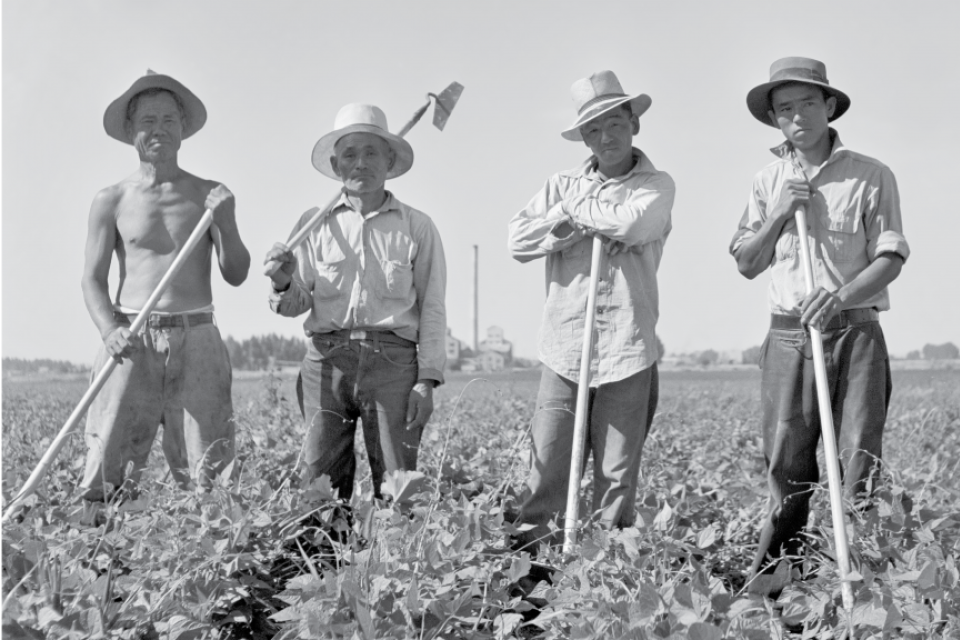FOR IMMEDIATE RELEASE - August 22, 2016
PRESS CONTACTS:
Leslie Unger - lunger@janm.org - 213-830-5690

JANM EXHIBITION TO SHOWCASE PHOTOGRAPHS FROM WWII FARM LABOR CAMPS
The Japanese American National Museum will present Uprooted: Japanese American Farm Labor Camps During World War II, a traveling exhibition featuring the work of Farm Security Administration photographer Russell Lee in Oregon and Idaho, from September 27, 2016, to January 8, 2017.
During World War II, the United States government forcibly removed over 120,000 Japanese Americans from the Pacific Coast. These individuals, two-thirds of them US citizens, were sent to ten concentration camps. In some cases, they were first placed in one of 16 assembly centers while the camps were still being built. Between 1942 and 1944, thousands of these Japanese Americans were then moved from assembly centers and concentration camps to farm labor camps as a way to mitigate the wartime labor shortage. Some 33,000 individual contracts were issued for seasonal farm labor, with many Japanese Americans assigned to work in the sugar beet industry, which played a vital role in producing munitions and synthetic rubber for the military. Under this seasonal leave program, Japanese Americans could earn better wages while contributing to the war effort.
In the summer of 1942, Farm Security Administration (FSA) photographer Russell Lee visited four Japanese American farm labor camps located near the towns of Nyssa, Oregon; and Rupert, Shelley, and Twin Falls, Idaho. He captured the laborers’ day-to-day lives in evocative detail, producing rare images of a little-documented episode of American history. Lee also recorded the forced removal of individuals and families in California, taking a total of nearly 600 photographs of the Japanese American wartime experience. According to his biographer, F. Jack Hurley, Lee abhorred the government’s treatment of Japanese Americans during the war and wanted to document what he described as a very dark period in American history.
Uprooted: Japanese American Farm Labor Camps During World War II showcases a selection of Lee’s farm labor camp photographs accompanied by his original captions. Many of these images have never before been exhibited. The exhibition also includes a short documentary film featuring firsthand accounts of life in the camps. An extensive website at uprootedexhibit.com provides materials for further study, including photographs not in the exhibition, historic documents, video clips, transcripts from oral history interviews, and lesson plans. Uprooted seeks to contextualize Lee’s images within the history of the FSA as well as Japanese American camp life in the two states.
From 1935 to 1944, the FSA’s renowned documentary photography program produced approximately 175,000 black-and-white film negatives and 1,600 color images. Trained as a chemical engineer, Russell Lee joined Roy Stryker’s staff of FSA photographers in 1936. He continued to work for the New Deal agency until 1943. Lee was by far the most prolific of the agency’s photographers, producing more than 5,000 images in less than seven years. Perhaps best known for his series on Pie Town, New Mexico, Lee photographed across the United States.
Uprooted: Japanese American Farm Labor Camps During World War II exhibition was organized by the Oregon Cultural Heritage Commission (OCHC) and funded, in part, by grants from the US Department of the Interior, National Park Service, Japanese American Confinement Sites Grant Program; the Idaho Humanities Council, a State-based program of the National Endowment for the Humanities; Fred W. Fields Fund of the Oregon Community Foundation; the Rose E. Tucker Charitable Trust; and the Malheur County Cultural Trust.
NOW ON VIEW AT JANM:
Tatau: Marks of Polynesia
Through January 8, 2017
Tatau: Marks of Polynesia explores Samoan tattoo practice through photographs that showcase the work of traditional tatau masters alongside more contemporary manifestations of the art form. Curated by author and master tattoo artist Takahiro “Ryudaibori” Kitamura with photography by John Agcaoili, Tatau highlights the beauty of the Samoan tattoo tradition as well as its key role in the preservation and propagation of Samoan culture.
Common Ground: The Heart of Community
Ongoing
Incorporating hundreds of objects, documents, and photographs collected by JANM, this exhibition chronicles 130 years of Japanese American history, from the early days of the Issei pioneers through the World War II incarceration to the present.
About the Japanese American National Museum (JANM)
Established in 1985, the Japanese American National Museum promotes understanding and appreciation of America’s ethnic and cultural diversity by sharing the Japanese American experience. Located in the historic Little Tokyo district of downtown Los Angeles, JANM is a hybrid institution that straddles traditional museum categories and strives to provide a voice for Japanese Americans as well as a forum that enables all people to explore their own heritage and culture. Since opening to the public, JANM has presented over 70 exhibitions onsite and traveled 17 of its exhibitions to locations around the world, including the Smithsonian Institution and the Ellis Island Museum in the United States, and several leading cultural museums in Japan and South America.
JANM is located at 100 N. Central Ave., Los Angeles. Museum hours are Tuesday, Wednesday, Friday, Saturday, and Sunday from 11 a.m. to 5 p.m. and Thursday from noon to 8 p.m. General admission is $9 adults, $5 students and seniors, free for members and children under age five. Admission is free to everyone on Thursdays from 5 p.m. to 8 p.m. and every third Thursday of the month from noon to 8 p.m. General admission prices and free admission times may not apply to specially ticketed exhibitions. Closed Monday, 4th of July, Thanksgiving, Christmas, and New Year’s Day. For more information visit janm.org or call 213.625.0414.
Please note: Effective September 1, 2016, admission prices will change to $10 for adults and $6 for students and seniors.

